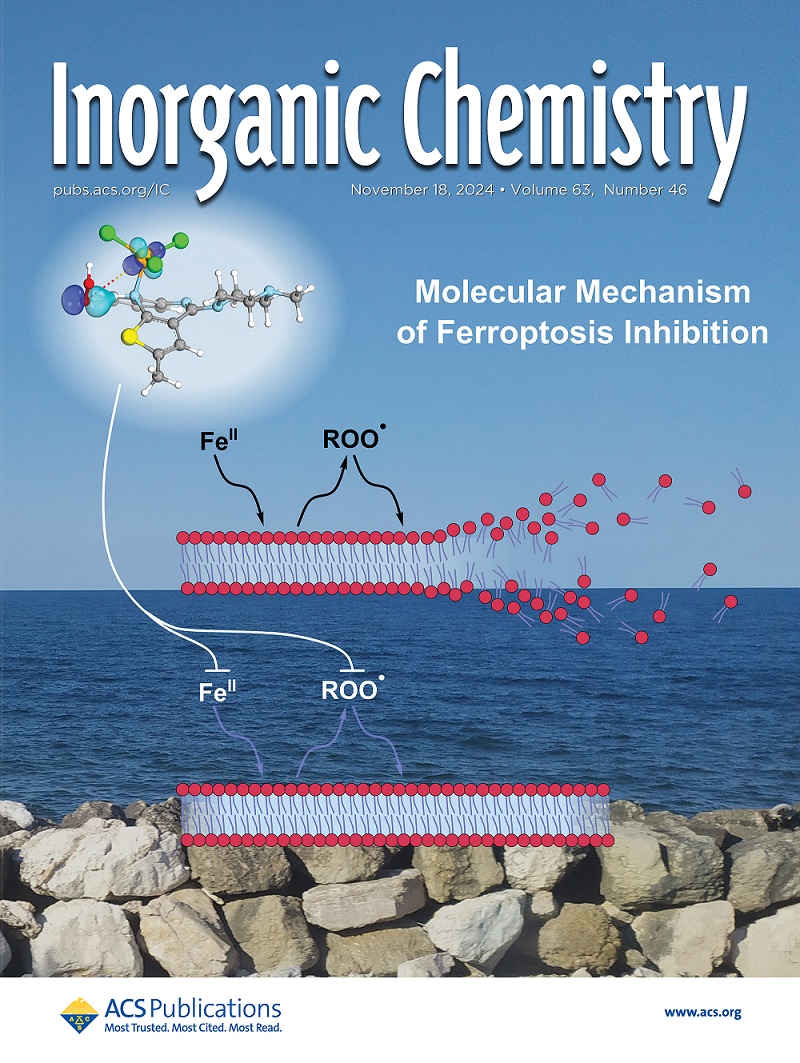富氧镍氧化物氧超氧化物和氧过氧化物的性质及其异质结构。
IF 4.3
2区 化学
Q1 CHEMISTRY, INORGANIC & NUCLEAR
引用次数: 0
摘要
利用密度泛函理论计算镍取代过渡金属五氧化物M2O5的化学特性,研究了富氧镍氧化物的化学特性,并利用进化算法预测了晶体结构的基态结构。我们的研究结果表明,Ni5+在氧化物环境中不太可能稳定,并且会通过分子氧的形成立即还原为更稳定的镍氧化态(Ni4+-Ni2+),而超氧化物和过氧化物的可能性相同。由此得到的氧过氧化物和氧超氧化物相代表了已知的或长期怀疑的二元镍氧化物(NiO, Ni2O3, NiO2)的富氧版本及其异质结构,包括O2修饰的岩盐NiO,富o层状cdi2型NiO2, NiO2和NiO(O2)的der Waals异质结构以及所有已知的五氧化物常见的单斜C2/c形式(高压V2O5型结构)。而镍则以氧化超氧化物Ni2O3(O2)的形式存在。虽然所有的预测模型都是动态稳定的,但在还原为一氧化镍(最稳定的氧化镍相)时却非常不稳定,这就解释了为什么NiO2以外的富氧氧化镍相尚未被观察到。本文章由计算机程序翻译,如有差异,请以英文原文为准。
Identity of Oxygen-Rich Nickel Oxides as Oxosuperoxides and Oxoperoxides and Their Heterostructures.
The chemical identity of oxygen-rich nickel oxides was investigated employing Density Functional Theory calculations performed for Ni-substituted transition-metal pentoxides M2O5, which have the potential to host M5+ species, while the ground-state structure was predicted using evolutionary algorithms for crystal structure prediction. Our results have shown that Ni5+ is unlikely to stabilize in the oxide environment and will immediately reduce to more stable nickel oxidation states (Ni4+-Ni2+) through the formation of molecular oxygen species, while both superoxide and peroxide species are equally likely. The resulting oxoperoxide and oxosuperoxide phases represent oxygen-enriched versions of the already well-known or long-suspected binary nickel oxides (NiO, Ni2O3, NiO2) and their heterostructures including O2-decorated rock salt NiO, O-enriched layered CdI2-type NiO2, a der Waals heterostructure of NiO2 and NiO(O2) as well as the monoclinic C2/c form (high-pressure V2O5 type structure), which is common to all known pentoxides, and in the case of nickel takes the form of oxosuperoxide Ni2O3(O2). All predicted models, although dynamically stable, were found to be highly unstable in relation to reduction to nickel monoxide, the most stable nickel oxide phase, which provides one explanation for why oxygen-rich nickel oxide phases beyond NiO2 have not yet been observed.
求助全文
通过发布文献求助,成功后即可免费获取论文全文。
去求助
来源期刊

Inorganic Chemistry
化学-无机化学与核化学
CiteScore
7.60
自引率
13.00%
发文量
1960
审稿时长
1.9 months
期刊介绍:
Inorganic Chemistry publishes fundamental studies in all phases of inorganic chemistry. Coverage includes experimental and theoretical reports on quantitative studies of structure and thermodynamics, kinetics, mechanisms of inorganic reactions, bioinorganic chemistry, and relevant aspects of organometallic chemistry, solid-state phenomena, and chemical bonding theory. Emphasis is placed on the synthesis, structure, thermodynamics, reactivity, spectroscopy, and bonding properties of significant new and known compounds.
 求助内容:
求助内容: 应助结果提醒方式:
应助结果提醒方式:


